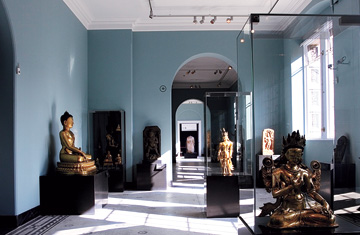
Likenesses of Buddha are these days so commonplace — the casual adornment of fashionable spas, fusion restaurants and Parisian nightclubs — that it is strange to think that artists once hesitated, out of reverence, to portray the Buddha in corporeal form. In 2nd century India, judging by a 2nd century sandstone carving excavated from Mathura, it was sufficient to simply depict an empty throne — the implication that the Buddha was a spiritual king being very clearly understood by anyone who saw it.
But as the stunning new gallery of Buddhist sculpture at London's Victoria and Albert Museum makes plain, somewhere along the line the reticence about rendering the Buddha's likeness gave way, and the world embarked on two millenniums of rich iconography and statuary. The gallery's 47 masterworks, culled from the museum's renowned Asian collections, trace the Buddha's portrayal from the 2nd to 19th centuries, in places as diverse as India, Java and Japan.
Inspiration came from unexpected sources. Some sculptors in Sri Lanka and China simply shaped the Buddha in their own likenesses. A 4th century stucco bust unearthed in Afghanistan features the full lips associated with Indian Gupta art, but also fulsome curls that reflect the Greco-Roman artists brought to the region by Alexander the Great.
Other enlightened souls are shown beside the Buddha. Among the gallery's most glorious artifacts are depictions of bodhisattvas — those who deliberately postpone their passage to nirvana, Buddhists believe, in order to help others along the eightfold path. In the 14th century, metalworkers from Nepal's Kathmandu Valley crafted the Bodhisattva Avalokiteshvara, a manifestation of the Buddhist lord of compassion, in gilded copper and precious-stone inlay. An androgynous-looking deity with wide hips and sensuous form (in Chinese tradition, Avalokiteshvara or Guan Yin is female, in others male), Avalokiteshvara's serene face projects the harmony to which all Buddhists aspire.
John Clarke, the gallery's principal curator, says that Avalokiteshvara is sometimes depicted holding a blooming lotus — a symbol of spiritual purity. "It comes up from the mud, flowers, and remains untouched by the dirt that surrounded it," he says. You could say the same thing for the wonderful richness of Buddhist art. See www.vam.ac.uk for more.
